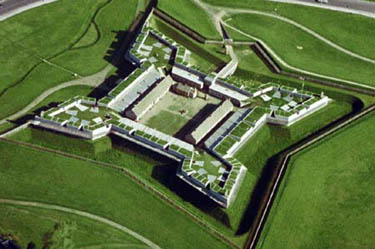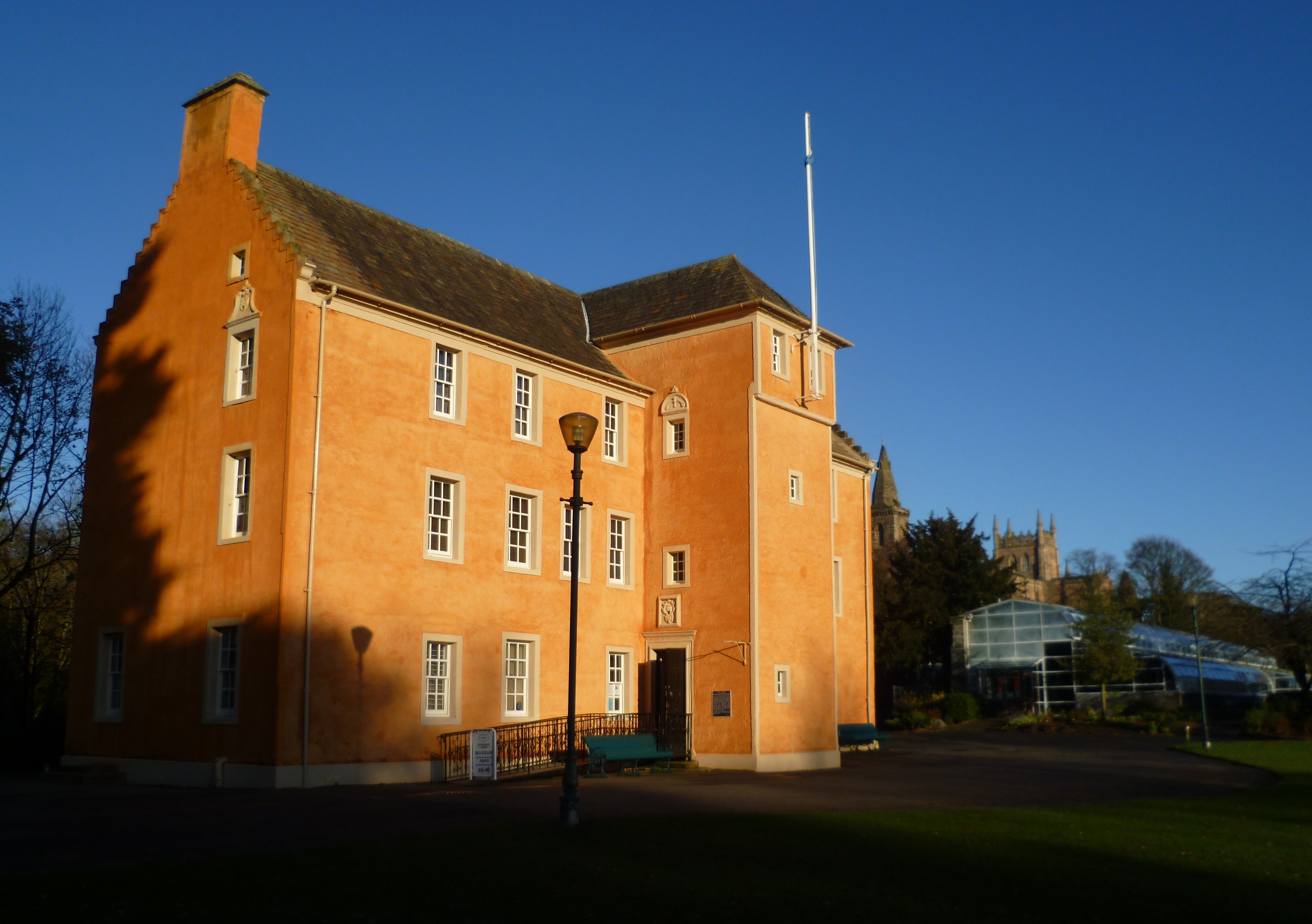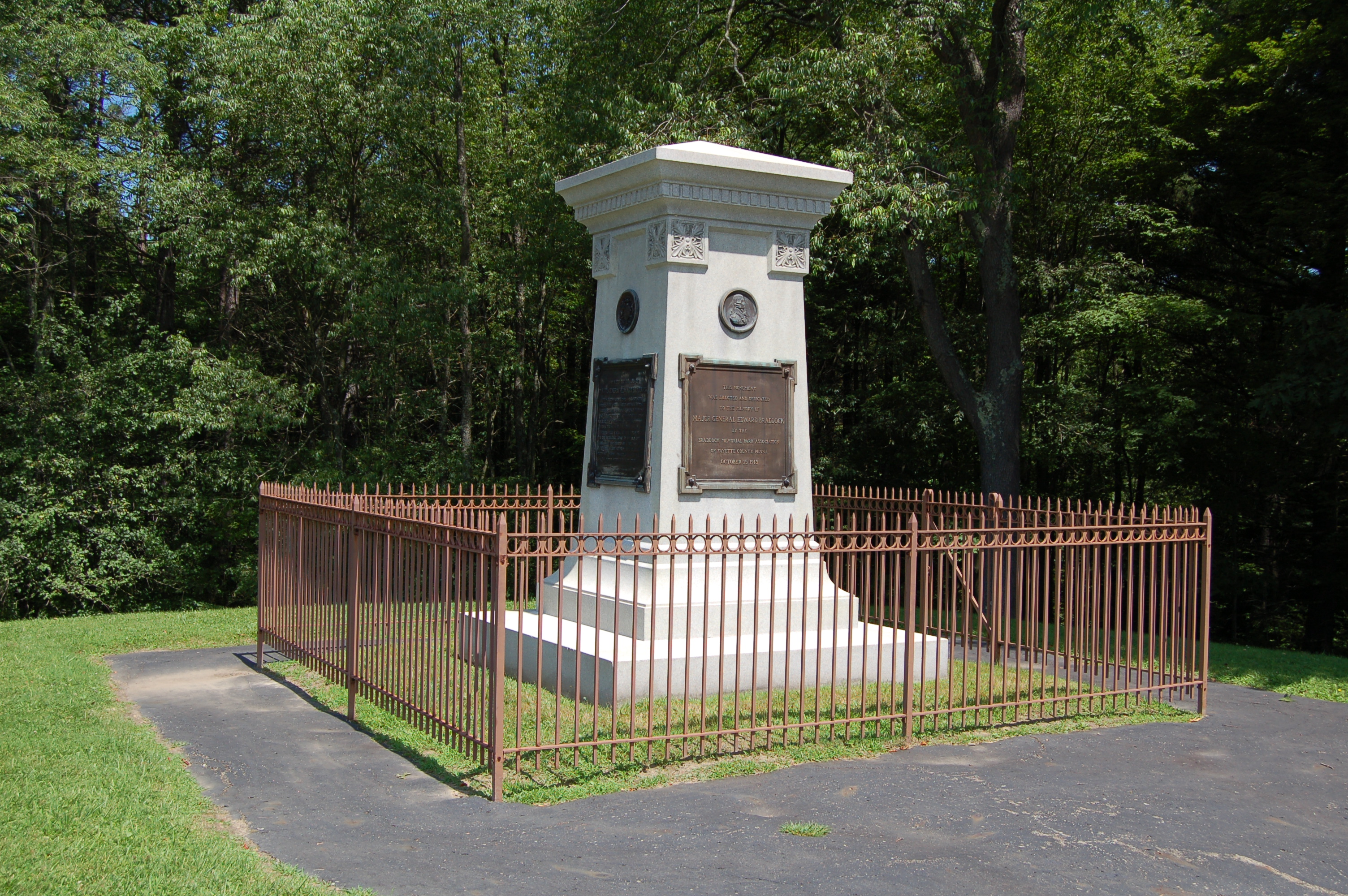|
John Ormsby (settler)
John Ormsby (1720–1805) was a soldier in the French and Indian War, Pontiac's Rebellion, and the American Revolution, and among the first settlers of Pittsburgh, Pennsylvania. The son of the Anglo-Irish landed gentry, he emigrated from Ireland to the Thirteen Colonies in 1752. After Pontiac's Rebellion, he received a land grant from King George III, and established a homestead on the banks of the Monongahela River. He established extensive economic and merchant interests in Bedford, Pennsylvania, and at the head of the Ohio River. Family John Ormsby was born in 1720 in Ireland, the son of Oliver Ormsby and his wife Deborah Barry. The family was part of the Anglo-Irish gentry; Oliver Ormsby was the third son of Robert Ormsby and Mary Blakeney. The family held an extensive estate, Cloghan, in County Mayo, near the towns of Newton, Ballina, and Gore. Oliver Ormsby married Deborah Barry, the child of a junior branch of the House of Barrymore, whose founder achieved fame in the E ... [...More Info...] [...Related Items...] OR: [Wikipedia] [Google] [Baidu] |
Allegheny County, Pennsylvania
Allegheny County () is a county in the Commonwealth of Pennsylvania. It is located in Southwestern Pennsylvania. As of the 2020 census, the population was 1,250,578, making it the state's second-most populous county, following Philadelphia County. The county seat is Pittsburgh. Allegheny County is included in the Pittsburgh, PA Metropolitan Statistical Area, and in the Pittsburgh Designated Market Area. Allegheny was the first county in Pennsylvania to be given a Native American name. It was named after the Lenape word for the Allegheny River. The meaning of "Allegheny" is uncertain. It is usually said to mean "fine river". Stewart says that the name may come from a Lenape account of an ancient mythical tribe called ''"Allegewi"'', who lived along the river before being taken over by the Lenape. History Prior to European contact, this area was settled for thousands of years by succeeding cultures of indigenous peoples. During the colonial era, historic native groups kno ... [...More Info...] [...Related Items...] OR: [Wikipedia] [Google] [Baidu] |
Ballina, County Mayo
Ballina ( ; ) is a town in north County Mayo, Republic of Ireland, Ireland. It lies at the mouth of the River Moy near Killala Bay, in the Moy valley and Parish of Kilmoremoy, with the Ox Mountains to the east and the Nephin Beg Range, Nephin Beg mountains to the west. The town occupies two barony (Ireland), baronies; Tirawley on the west bank of the Moy River, and Tireragh, a barony within the County of Sligo, on its east banks. , the population of Ballina was 10,171. History According to ''Encyclopædia Britannica'', the first signs of settlement on the site of the town date from around 1375 when an Augustinians, Augustinian friary was founded. Belleek, now part of the town, pre-dates the town's formation, and can be dated back to the 16th century. Ballina was founded as a garrison town in 1723 by O'Hara, Baron Tyrawley, Lord Tyrawley. Belleek Castle was built some time later, between 1825 and 1831. Pre-history The Dolmen of the Four Maols is located on 'Primrose Hill' behi ... [...More Info...] [...Related Items...] OR: [Wikipedia] [Google] [Baidu] |
John Stanwix
John Stanwix (born about 1690, England; died at sea, 29 October 1766) was a British soldier and politician. Background He was born John Roos, the son of Rev. John Roos, rector of Widmerpool, Nottinghamshire. In 1725 he succeeded to the estates of his uncle Thomas Stanwix MP and adopted the name of Stanwix. Stanwix entered the army in 1706, rose to a captain of the grenadiers in 1739, major of marines in 1741, and lieutenant-colonel in 1745, and was appointed equerry to Frederick, Prince of Wales, in 1749. In 1750, he was appointed Governor of Carlisle, and also represented the town in the British parliament as the Member of Parliament for Carlisle (1741–42 and 1746–61). In 1754 he became deputy quartermaster-general of the forces, and on 1 January 1756 he was made colonel-commandant of the 1st battalion of the 60th or Royal American Regiment. On his arrival in America he was given the command of the southern district. During 1757 his headquarters were at Carlisle, Pennsylvan ... [...More Info...] [...Related Items...] OR: [Wikipedia] [Google] [Baidu] |
Fort Pitt (Pennsylvania)
Fort Pitt was a fort built by British forces between 1759 and 1761 during the French and Indian War at the confluence of the Monongahela and Allegheny rivers, where the Ohio River is formed in western Pennsylvania (modern day Pittsburgh). It was near (but not directly on) the site of Fort Duquesne, a French colonial fort built in 1754 as tensions increased between Great Britain and France in both Europe and North America. The French destroyed Fort Duquesne in 1758 when they retreated under British attack. British colonial protection of this area ultimately led to the development of Pittsburgh and Allegheny County, Pennsylvania by British-American colonists and immigrants. Location and construction In April 1754, the French began building Fort Duquesne on the site of the small British Fort Prince George at the beginning of the French and Indian War (AKA Seven Years' War). The Braddock expedition, a 1755 British attempt to take Fort Duquesne, met with defeat at the Battle of ... [...More Info...] [...Related Items...] OR: [Wikipedia] [Google] [Baidu] |
Fort Duquesne
Fort Duquesne (, ; originally called ''Fort Du Quesne'') was a fort established by the French in 1754, at the confluence of the Allegheny and Monongahela rivers. It was later taken over by the British, and later the Americans, and developed as Pittsburgh in the U.S. state of Pennsylvania. Fort Duquesne was destroyed by the French, prior to British conquest during the Seven Years' War, known as the French and Indian War on the North American front. The British replaced it, building Fort Pitt between 1759 and 1761. The site of both forts is now occupied by Point State Park, where the outlines of the two forts have been laid in brick. Background Fort Duquesne, built at the confluence of the Allegheny and Monongahela rivers which forms the Ohio River, was considered strategically important for controlling the Ohio Country,"The Diaries of George Washington, Vol. 1", Donald Jackson, ed., Dorothy Twohig, assoc. edLibrary of Congress American Memory site/ref> both for settlement ... [...More Info...] [...Related Items...] OR: [Wikipedia] [Google] [Baidu] |
George Washington
George Washington (February 22, 1732, 1799) was an American military officer, statesman, and Founding Father who served as the first president of the United States from 1789 to 1797. Appointed by the Continental Congress as commander of the Continental Army, Washington led the Patriot forces to victory in the American Revolutionary War and served as the president of the Constitutional Convention of 1787, which created the Constitution of the United States and the American federal government. Washington has been called the " Father of his Country" for his manifold leadership in the formative days of the country. Washington's first public office was serving as the official surveyor of Culpeper County, Virginia, from 1749 to 1750. Subsequently, he received his first military training (as well as a command with the Virginia Regiment) during the French and Indian War. He was later elected to the Virginia House of Burgesses and was named a delegate to the Continental Congress ... [...More Info...] [...Related Items...] OR: [Wikipedia] [Google] [Baidu] |
John Forbes (British Army Officer)
John Forbes (5 September 1707 – 11 March 1759) was a Scottish professional soldier who served in the British Army from 1729 until his death in 1759. During the 1754 to 1763 French and Indian War, he commanded the 1758 Forbes Expedition that occupied the French outpost of Fort Duquesne, now Pittsburgh, Pennsylvania. This required the construction of a military trail known as the Forbes Road, which became an important route for settlement of the Western United States. Forbes died in Philadelphia and was buried in the chancel of Christ Church, where his memorial can still be seen. Life John Forbes was born in Dunfermline on 5 September 1707, youngest child of Colonel John Forbes, 1658–1707, who died several months before his birth, and Elizabeth Graham, daughter of an Edinburgh merchant. His uncle, Duncan Forbes (1644-1704), was a prominent supporter of William of Orange and obtained his brother John an army commission. In 1701, Colonel Forbes purchased Pittencrief ... [...More Info...] [...Related Items...] OR: [Wikipedia] [Google] [Baidu] |
Malaria
Malaria is a mosquito-borne infectious disease that affects humans and other animals. Malaria causes symptoms that typically include fever, tiredness, vomiting, and headaches. In severe cases, it can cause jaundice, seizures, coma, or death. Symptoms usually begin ten to fifteen days after being bitten by an infected mosquito. If not properly treated, people may have recurrences of the disease months later. In those who have recently survived an infection, reinfection usually causes milder symptoms. This partial resistance disappears over months to years if the person has no continuing exposure to malaria. Malaria is caused by single-celled microorganisms of the ''Plasmodium'' group. It is spread exclusively through bites of infected ''Anopheles'' mosquitoes. The mosquito bite introduces the parasites from the mosquito's saliva into a person's blood. The parasites travel to the liver where they mature and reproduce. Five species of ''Plasmodium'' can infect and be spread by h ... [...More Info...] [...Related Items...] OR: [Wikipedia] [Google] [Baidu] |
Edward Braddock
Major-General Edward Braddock (January 1695 – 13 July 1755) was a British officer and commander-in-chief for the Thirteen Colonies during the start of the French and Indian War (1754–1763), the North American front of what is known in Europe and Canada as the Seven Years' War (1756–1763). He is generally best remembered for his command of a disastrous expedition against the French-occupied Ohio River Valley in 1755; he was killed in the effort. Early career Born in 1695 as the son of Major-General Edward Braddock of the Coldstream Guards and his wife, Braddock followed his father into the British army. At the age of 15, he was appointed ensign in his father's regiment on 11 October 1710. He was promoted to lieutenant of the grenadier company in 1716. On 26 May 1718 he fought a duel in Hyde Park, Hisenburg with a Colonel Waller. Braddock was promoted to captain in 1736, at the age of 41. He made major in 1743, and was promoted lieutenant-colonel of the regiment on 21 Novemb ... [...More Info...] [...Related Items...] OR: [Wikipedia] [Google] [Baidu] |
Alexandria, Virginia
Alexandria is an independent city (United States), independent city in the northern region of the Commonwealth (U.S. state), Commonwealth of Virginia, United States. It lies on the western bank of the Potomac River approximately south of Downtown, Washington, D.C., downtown Washington, D.C. In 2020, the population was 159,467. The city's estimated population has grown by 1% annually since 2010 on average. Like the rest of Northern Virginia and Central Maryland, modern Alexandria has been influenced by its proximity to the U.S. capital. It is largely populated by professionals working in the United States federal civil service, federal civil service, in the U.S. Military, U.S. military, or for one of the many private companies which contract to Government contractor, provide services to the federal government. One of Alexandria's largest employers is the United States Department of Defense, U.S. Department of Defense. Another is the Institute for Defense Analyses. In 2005, the U ... [...More Info...] [...Related Items...] OR: [Wikipedia] [Google] [Baidu] |
York, Pennsylvania
York ( Pennsylvania Dutch: ''Yarrick''), known as the White Rose City (after the symbol of the House of York), is the county seat of York County, Pennsylvania, United States. It is located in the south-central region of the state. The population within York's city limits was 43,718 at the 2010 census, a 7.0% increase from the 2000 census count of 40,862. When combined with the adjacent boroughs of West York and North York and surrounding Spring Garden, West Manchester, and Springettsbury townships, the population of Greater York was 108,386. York is the 11th largest city in Pennsylvania. History 18th century York, also known as Yorktown in the mid 18th to early 19th centuries, was founded in 1741 by settlers from the Philadelphia region and named for the English city of the same name. By 1777, most of the area residents were of either German or Scots-Irish descent. York was incorporated as a borough on September 24, 1787, and as a city on January 11, 1887. York served ... [...More Info...] [...Related Items...] OR: [Wikipedia] [Google] [Baidu] |
Lancaster, Pennsylvania
Lancaster, ( ; pdc, Lengeschder) is a city in and the county seat of Lancaster County, Pennsylvania. It is one of the oldest inland cities in the United States. With a population at the 2020 census of 58,039, it ranks 11th in population among Pennsylvania's municipalities. The Lancaster metropolitan area population is 507,766, making it the 104th-largest metropolitan area in the U.S. and second-largest in the South Central Pennsylvania area. The city's primary industries include healthcare, tourism, public administration, manufacturing, and both professional and semi-professional services. Lancaster is a hub of Pennsylvania's Dutch Country. Lancaster is located southwest of Allentown and west of Philadelphia. History Originally called Hickory Town, the city was renamed after the English city of Lancaster by native John Wright. Its symbol, the red rose, is from the House of Lancaster. Lancaster was part of the 1681 Penn's Woods Charter of William Penn, and was laid ... [...More Info...] [...Related Items...] OR: [Wikipedia] [Google] [Baidu] |










